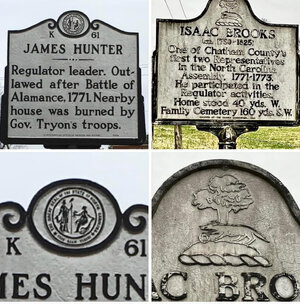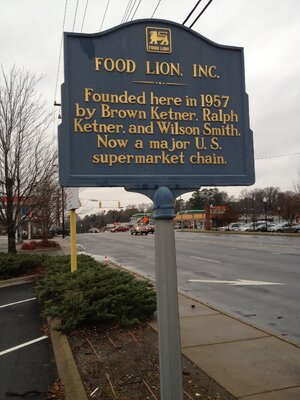donbosco
Inconceivable Member
- Messages
- 4,645
Isaac Brooks was an early Chathamite and a prominent man involved in colonial and Independence Era politics and business. There are many stories about actions he may, or may not, have been involved in during those times.
In 1959 a petition was submitted to The NC Historical Marker Program for Brooks to be remembered with a marker. For some reason that petition was denied and no marker was erected.
In 1962 a marker was, nevertheless erected on “Ike Brooks Road” near #Bonlee and the banks of #TickCreek just off modern (New) Highway 421. The sign itself states, “Erected by The Brooks Association, ~ 1962.” I remember this sign in my earliest memories. It is located very near to my Deddy’s Homeplace near Sandy Branch.
In full, the marker reads: “Isaac Brooks (~1730-1825). One of Chatham County’s first two Representatives in the North Carolina Assembly, 1771-1773. He participated in the Regulator activities. Home stood 40 yds W. Family Cemetery 160 yds S.W. [Erected by The Brooks Association, ~ 1962].
No one can actually be sure how many unofficial markers dot the landscape of North Carolina and my guess is that most are paid virtually no mind. One key to legitimacy is that a marker must only be located on numbered state or federal highways, meaning restricted access routes, city streets, and SRs (State Roads) are not eligible for one. There are some other criteria that must be met. That something is not memorialized does not mean that it is not worthy of that recognition but rather that either it has not been submitted for consideration or that the application did not meet the requirements. See here for more on the specs: NC Highway Historical Marker Program | NC DNCR
Isaac Brooks IS commemorated in that area by a stretch of Highway 421 that bears his name running from the Chatham/Lee County Line to Troy Estate Road near the Chatham/Randolph border. That naming was done by The NC Department of Transportation in 1997 in recognition of the fact that in 1773 Brooks proposed that a road be built from Fayetteville (Then Campbelltown) through Chatham that takes a path very close to the modern highway.
In the photos is one of the Brooks marker and an actual NCDCR one (James Hunter, Regulator Leader) - look closely and you can see the difference. Most prominently the Brooks marker does not bear the official state seal but rather in the same spot a rendering of a tree, a millstone (?), and a running canine (a fox?).
Official markers also bear a Letter-Number Code. When the program began in 1935 the state was divided into districts (lettered) and within those areas the signs are numbered.
Now that you know this and what to look for, do you think that you might know of an unofficial marker somewhere?

In 1959 a petition was submitted to The NC Historical Marker Program for Brooks to be remembered with a marker. For some reason that petition was denied and no marker was erected.
In 1962 a marker was, nevertheless erected on “Ike Brooks Road” near #Bonlee and the banks of #TickCreek just off modern (New) Highway 421. The sign itself states, “Erected by The Brooks Association, ~ 1962.” I remember this sign in my earliest memories. It is located very near to my Deddy’s Homeplace near Sandy Branch.
In full, the marker reads: “Isaac Brooks (~1730-1825). One of Chatham County’s first two Representatives in the North Carolina Assembly, 1771-1773. He participated in the Regulator activities. Home stood 40 yds W. Family Cemetery 160 yds S.W. [Erected by The Brooks Association, ~ 1962].
No one can actually be sure how many unofficial markers dot the landscape of North Carolina and my guess is that most are paid virtually no mind. One key to legitimacy is that a marker must only be located on numbered state or federal highways, meaning restricted access routes, city streets, and SRs (State Roads) are not eligible for one. There are some other criteria that must be met. That something is not memorialized does not mean that it is not worthy of that recognition but rather that either it has not been submitted for consideration or that the application did not meet the requirements. See here for more on the specs: NC Highway Historical Marker Program | NC DNCR
Isaac Brooks IS commemorated in that area by a stretch of Highway 421 that bears his name running from the Chatham/Lee County Line to Troy Estate Road near the Chatham/Randolph border. That naming was done by The NC Department of Transportation in 1997 in recognition of the fact that in 1773 Brooks proposed that a road be built from Fayetteville (Then Campbelltown) through Chatham that takes a path very close to the modern highway.
In the photos is one of the Brooks marker and an actual NCDCR one (James Hunter, Regulator Leader) - look closely and you can see the difference. Most prominently the Brooks marker does not bear the official state seal but rather in the same spot a rendering of a tree, a millstone (?), and a running canine (a fox?).
Official markers also bear a Letter-Number Code. When the program began in 1935 the state was divided into districts (lettered) and within those areas the signs are numbered.
Now that you know this and what to look for, do you think that you might know of an unofficial marker somewhere?



